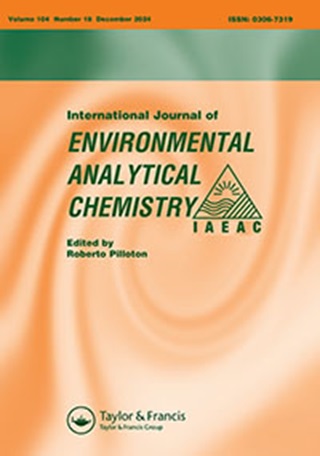苯二氮卓类药物生物传感器检测进展综述
IF 2.5
4区 化学
Q3 CHEMISTRY, ANALYTICAL
International Journal of Environmental Analytical Chemistry
Pub Date : 2023-10-04
DOI:10.1080/03067319.2023.2261008
引用次数: 0
摘要
一类被称为苯二氮卓类的精神活性化合物通常用于治疗包括焦虑、抑郁和持续性疼痛在内的疾病。苯二氮卓类药物的使用和误用正在逐渐增加,需要准确的检测程序来跟踪患者的使用情况和依从性。确定生物标本中苯二氮卓类药物的存在是许多科学家非常感兴趣的问题。使用苯二氮卓类药物以及在其影响下的致命或犯罪行为正在成为全球关注的主要问题。苯二氮卓类药物也被认为是对水生环境影响最大的新兴关注污染物。由于BZD药物的毒性作用,广泛的可获得性和耐光降解性,并且在地表水中停留数月显示出对环境的关注,因此其痕量检测非常重要。用于苯二氮卓类药物检测的一些方法有气相色谱-质谱-电子捕获(GC-EC)、薄层色谱(TLC)、高效液相色谱(HPLC)和免疫分析法。这些方法应用广泛,结果可靠、准确。同时,它们有可能严重危害工作场所的安全,容易产生交叉反应,而且不足以得出高度选择性的结论。因此,迫切需要一些快速、选择性的苯二氮卓类药物检测技术。使用基于纳米材料的生物传感器,即使在极小的样本量下,也可以以极高的灵敏度和选择性连续监测苯二氮卓类药物,这是用于此目的的极好的仪器。本研究集中于苯二氮卓类药物快速实时诊断的现状。它还涵盖了几种传统方法的潜在发展,用于超低水平的快速检测,传授有关传感器技术未来的知识。对苯二氮卓类药物的分类、作用机理以及各种苯二氮卓类衍生物(BDZs)进行了讨论。用于分析最常见的苯二氮卓类药物及其代谢物的不同纳米传感器的最新发展是本研究的主要主题。苯二氮卓类药物快速、快速和现场诊断的现状。讨论了用于苯二氮卓类药物检测的一些常规技术。本文综述了生物传感技术的发展前景和可能性。关键词:非法药物、生物传感器、医疗器械、诊断信息披露声明作者未报告潜在利益冲突。本研究由印度科技部生物技术司资助[BT/PR31594/MED/32/738/2020]。本文章由计算机程序翻译,如有差异,请以英文原文为准。
A review on advancement of biosensors for benzodiazepines detection
ABSTRACTA class of psychoactive compounds known as benzodiazepines are usually given for illnesses including anxiety, depression and persistent pain. The usage and misuse of benzodiazepines are gradually increasing, and accurate detection procedures are required to keep track of patient usage and compliance. It is of tremendous interest to many scientists to determine the presence of benzodiazepines in biological specimen. The use of benzodiazepines as drugs and deadly or criminal behaviour while under their influence are becoming major global concerns. Benzodiazepines are also considered as contaminants of emerging concern (CECs) that has mostly impacted on aquatic environments. BZD drugs are mostly abused due to their toxic effects, widespread availability and the resistant to photodegradation and remain on the surface water for several months shows the environment concern so their trace amount of detection is important. Some of the methods used for benzodiazepine detection are gas chromatography combined with mass spectrometry and electron capture (GC-MS) (GC-EC), thin-layer chromatography (TLC), high-performance liquid chromatography (HPLC) and immunoassay methods. These methods are widely used, producing reliable and accurate results. At the same time, they have the potential to seriously compromise workplace safety, are prone to cross-reactivities and are insufficient for highly selective conclusions. Therefore, there is an urgent need for some rapid and selective techniques for benzodiazepine detection. Benzodiazepines may be continually monitored with exceptional sensitivity as well as selectivity even at extremely minimal sample volumes using nanomaterial-based biosensors, which are excellent instruments for this purpose. This study concentrates on the status of benzodiazepine fast and real-time diagnostics. It also covers the potential development of several conventional approaches for quick detection at ultra-low levels, imparting knowledge about the future of sensor technology. Some of the classification, mechanism of action of benzodiazepines as well as various benzodiazepine derivative drugs (BDZs) are also discussed. Current developments in different nanosensors designed to analyse the most prevalent benzodiazepines and their metabolites are the main topic of this study.HIGHLIGHTS Status of fast, rapid and on-spot diagnosis of benzodiazepine drugs.Some of the conventional techniques used for benzodiazepines detection are discussed.Biosensing methods with their future development and possibilities are summarised in this review.KEYWORDS: Illicit drugbiosensorpoint of care devicesdiagnostics Disclosure statementNo potential conflict of interest was reported by the author(s).Additional informationFundingThe work was supported by the Department of Biotechnology, Ministry of Science and Technology, India [BT/PR31594/MED/32/738/2020].
求助全文
通过发布文献求助,成功后即可免费获取论文全文。
去求助
来源期刊
CiteScore
5.90
自引率
7.70%
发文量
373
审稿时长
4.4 months
期刊介绍:
International Journal of Environmental Analytical Chemistry comprises original research on all aspects of analytical work related to environmental problems. This includes analysis of organic, inorganic and radioactive pollutants in air, water, sediments and biota; and determination of harmful substances, including analytical methods for the investigation of chemical or metabolic breakdown patterns in the environment and in biological samples.
The journal also covers the development of new analytical methods or improvement of existing ones useful for the control and investigation of pollutants or trace amounts of naturally occurring active chemicals in all environmental compartments. Development, modification and automation of instruments and techniques with potential in environment sciences are also part of the journal.
Case studies are also considered, particularly for areas where information is scarce or lacking, providing that reported data is significant and representative, either spatially or temporally, and quality assured. Owing to the interdisciplinary nature of this journal, it will also include topics of interest to researchers in the fields of medical science (health sciences), toxicology, forensic sciences, oceanography, food sciences, biological sciences and other fields that, in one way or another, contribute to the knowledge of our environment and have to make use of analytical chemistry for this purpose.

 求助内容:
求助内容: 应助结果提醒方式:
应助结果提醒方式:


